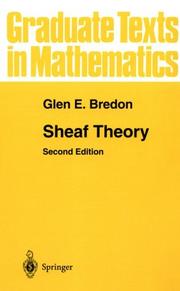| Listing 1 - 10 of 10 |
Sort by
|
Book
Year: 1967 Publisher: New York, NY : McGraw-Hill,
Abstract | Keywords | Export | Availability | Bookmark
 Loading...
Loading...Choose an application
- Reference Manager
- EndNote
- RefWorks (Direct export to RefWorks)
Algebraic topology. --- Sheaf theory. --- Topologie algébrique --- Faisceaux, Théorie des --- Topologie algebrique --- Homologie et cohomologie
Book
Year: 1980 Publisher: Liège : Université de Liège. Institut de mathématique,
Abstract | Keywords | Export | Availability | Bookmark
 Loading...
Loading...Choose an application
- Reference Manager
- EndNote
- RefWorks (Direct export to RefWorks)
Algebraic topology. --- Sheaf theory. --- Topologie algébrique --- Faisceaux, Théorie des --- Topologie algebrique --- Homologie et cohomologie
Book
Year: 1970 Publisher: Stuttgart : Teubner,
Abstract | Keywords | Export | Availability | Bookmark
 Loading...
Loading...Choose an application
- Reference Manager
- EndNote
- RefWorks (Direct export to RefWorks)
Faisceaux, Théorie des --- Sheaf theory. --- Topologie algebrique --- Homologie et cohomologie
Book
Year: 1981 Publisher: Louvain : Université Catholique de Louvain,
Abstract | Keywords | Export | Availability | Bookmark
 Loading...
Loading...Choose an application
- Reference Manager
- EndNote
- RefWorks (Direct export to RefWorks)
Algebraic topology. --- Sheaf theory. --- Topologie algébrique --- Faisceaux, Théorie des --- Geometrie algebrique
Book
Year: 1958 Publisher: Paris : Hermann,
Abstract | Keywords | Export | Availability | Bookmark
 Loading...
Loading...Choose an application
- Reference Manager
- EndNote
- RefWorks (Direct export to RefWorks)
Algebraic topology. --- Sheaf theory. --- Topologie algébrique --- Faisceaux, Théorie des --- Algèbre homologique --- Algebra, Homological. --- Topologie algebrique --- Homologie et cohomologie
Book
ISBN: 3540116109 0387116109 3540394370 9783540116103 Year: 1982 Volume: 955 Publisher: Berlin : Springer-Verl.,
Abstract | Keywords | Export | Availability | Bookmark
 Loading...
Loading...Choose an application
- Reference Manager
- EndNote
- RefWorks (Direct export to RefWorks)
Analytical spaces --- Duality theory (Mathematics) --- Linear topological spaces. --- Vector bundles. --- Duality theory (Mathematics). --- Algebraic topology --- Sheaf theory --- Topologie algébrique --- Faisceaux, Théorie des --- Topologie algébrique --- Faisceaux, Théorie des --- Espaces vectoriels topologiques --- Linear topological spaces --- Topologie algébrique. --- Faisceaux, Théorie des.
Book
ISSN: 03031179 ISBN: 285629099X 9782856290996 Year: 2001 Volume: 271 Publisher: Paris Société mathématique de France
Abstract | Keywords | Export | Availability | Bookmark
 Loading...
Loading...Choose an application
- Reference Manager
- EndNote
- RefWorks (Direct export to RefWorks)
Sheaf theory. --- Induction (Mathematics) --- Abelian categories. --- Sheaf theory --- Integral transforms --- D-modules --- Faisceaux, Théorie des. --- Transformations intégrales. --- D-modules, Théorie des. --- Faisceaux, Théorie des. --- Transformations intégrales. --- D-modules, Théorie des.

ISBN: 0387949054 9780387949055 1461268540 1461206472 Year: 1997 Volume: 170 Publisher: New York : Springer,
Abstract | Keywords | Export | Availability | Bookmark
 Loading...
Loading...Choose an application
- Reference Manager
- EndNote
- RefWorks (Direct export to RefWorks)
This book is primarily concerned with the study of cohomology theories of general topological spaces with "general coefficient systems." Sheaves play several roles in this study. For example, they provide a suitable notion of "general coefficient systems." Moreover, they furnish us with a common method of defining various cohomology theories and of comparison between different cohomology theories. The parts of the theory of sheaves covered here are those areas important to algebraic topology. Sheaf theory is also important in other fields of mathematics, notably algebraic geometry, but that is outside the scope of the present book. Thus a more descriptive title for this book might have been Algebraic Topology from the Point of View of Sheaf Theory. Several innovations will be found in this book. Notably, the concept of the "tautness" of a subspace (an adaptation of an analogous notion of Spanier to sheaf-theoretic cohomology) is introduced and exploited throughout the book. The fact that sheaf-theoretic cohomology satisfies 1 the homotopy property is proved for general topological spaces. Also, relative cohomology is introduced into sheaf theory. Concerning relative cohomology, it should be noted that sheaf-theoretic cohomology is usually considered as a "single space" theory.
Sheaf theory --- Théorie des faisceaux --- Algebraic topology --- Topologie algébrique --- Faisceaux, Théorie des --- Algebra. --- Algebraic topology. --- Algebraic Topology. --- Topology --- Mathematics --- Mathematical analysis --- Sheaf theory. --- Topologie algébrique --- Faisceaux, Théorie des --- Topologie algebrique --- Homologie et cohomologie

ISBN: 3540206655 3642188680 9783540206651 Year: 2004 Publisher: Berlin Heidelberg New York : Springer,
Abstract | Keywords | Export | Availability | Bookmark
 Loading...
Loading...Choose an application
- Reference Manager
- EndNote
- RefWorks (Direct export to RefWorks)
Constructible and perverse sheaves are the algebraic counterpart of the decomposition of a singular space into smooth manifolds, a great geometrical idea due to R. Thom and H. Whitney. These sheaves, generalizing the local systems that are so ubiquitous in mathematics, have powerful applications to the topology of such singular spaces (mainly algebraic and analytic complex varieties). This introduction to the subject can be regarded as a textbook on "Modern Algebraic Topology'', which treats the cohomology of spaces with sheaf coefficients (as opposed to the classical constant coefficient cohomology). The first five chapters introduce derived categories, direct and inverse images of sheaf complexes, Verdier duality, constructible and perverse sheaves, vanishing and characteristic cycles. They also discuss relations to D-modules and intersection cohomology. The final chapters apply this powerful tool to the study of the topology of singularities, of polynomial functions and of hyperplane arrangements. Some fundamental results, for which excellent sources exist, are not proved but just stated and illustrated by examples and corollaries. In this way, the reader is guided rather quickly from the A-B-C of the theory to current research questions, supported in this by a wealth of examples and exercises.
Sheaf theory --- 515.14 --- Cohomology, Sheaf --- Sheaf cohomology --- Sheaves, Theory of --- Sheaves (Algebraic topology) --- Algebraic topology --- Mathematics --- Physical Sciences & Mathematics --- Geometry --- 515.14 Algebraic topology --- Sheaf theory. --- Topologie algébrique --- Faisceaux, Théorie des --- Algebraic topology. --- Algebraic geometry. --- Functions of complex variables. --- Algebraic Topology. --- Algebraic Geometry. --- Several Complex Variables and Analytic Spaces. --- Complex variables --- Elliptic functions --- Functions of real variables --- Algebraic geometry --- Topology --- Topologie algébrique --- Faisceaux, Théorie des --- Faisceaux --- Geometrie algebrique --- Topologie algebrique --- Cohomologie --- Homologie et cohomologie

ISBN: 9783642080821 3642080820 3662026619 3540518614 9783540518617 Year: 1990 Volume: 292 Publisher: Berlin : Springer-Verlag,
Abstract | Keywords | Export | Availability | Bookmark
 Loading...
Loading...Choose an application
- Reference Manager
- EndNote
- RefWorks (Direct export to RefWorks)
Sheaf theory --- Manifolds (Mathematics) --- Algebra, Homological --- Homological algebra --- Algebra, Abstract --- Homology theory --- Geometry, Differential --- Topology --- Cohomology, Sheaf --- Sheaf cohomology --- Sheaves, Theory of --- Sheaves (Algebraic topology) --- Algebraic topology --- Differential geometry. Global analysis --- 512.71 --- 512.71 Commutative rings and algebras. Local theory. Foundations of algebraic geometry --- Commutative rings and algebras. Local theory. Foundations of algebraic geometry --- Topologie algébrique --- Faisceaux, Théorie des --- Algebraic topology. --- Sheaf theory. --- Topologie algébrique --- Faisceaux, Théorie des --- Topologie algebrique --- Geometrie algebrique --- Equations aux derivees partielles sur une variete --- Homologie et cohomologie --- Cohomologie
| Listing 1 - 10 of 10 |
Sort by
|

 Search
Search Feedback
Feedback About
About Help
Help News
News